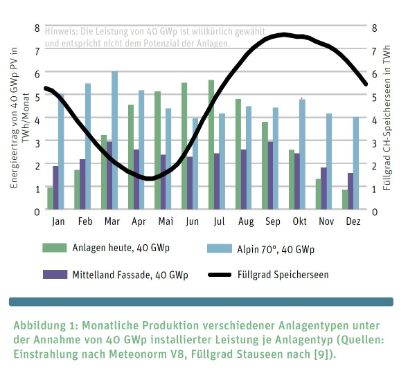- News
Photovoltaic potential in Switzerland
15.08.2022 There is sufficient PV potential on roof surfaces alone for the successful implementation of the Energy Strategy. Although façade, infrastructure, alpine or agri PV systems can help to achieve the goals faster and more reliably. Christof Bucher, Professor of Photovoltaic Systems and Head of the PV Laboratory at the Bern University of Applied Sciences BFH, has published an overview summarising the potential of various PV system types and assessing their relevance for winter electricity production in Switzerland.
For many years, there has been ongoing debate as to the best electricity mix for Switzerland. Now, in the summer of 2022, the energy crisis has added a new political dimension to the issue. Controversial opinions are given a platform in the media, ranging from “The federal government’s energy strategy is wishful thinking!” to “Let’s start producing solar power already!”. While people have differing opinions about social acceptance and political measures, there is often consensus on the technical side. For example, we know precisely how many buildings there are in Switzerland and how much solar power could be produced on their roofs. It is also known how much energy is generated in winter by PV systems on façades or in the Alps. In his compact overview, Christof Bucher, Professor of Photovoltaic Systems and Head of the PV Laboratory at Bern University of Applied Sciences (BFH), summarises some key facts and gives his assessment of the relevance of various PV potentials.
Pros and cons of the various types of system
The overview shows that the PV potential is spread over a variety of types of systems, each with different advantages and disadvantages. PV systems on roofs in the Swiss lowlands are cheapest, but produce the least winter electricity. Steeply angled alpine PV systems, on the other hand, are more expensive, but they have a higher yield in winter than in summer. The overview also shows that Switzerland’s existing PV installations generate a fairly modest level of energy in January, but are already producing close to their maximum output at the low point of the reservoirs in April/May.
PV systems support year-round power supply
The summer of 2022 has confirmed once again that hot, dry summers are becoming more frequent and more extreme. While some nuclear power plants are forced to restrict their output due to a lack of water in the rivers and too-high water temperatures, PV plants are reaching their maximum output and helping to relieve the pressure on Switzerland’s only long-term storage facilities currently available, the hydropower plants. PV systems are thus able to support the year-round supply of electricity.

